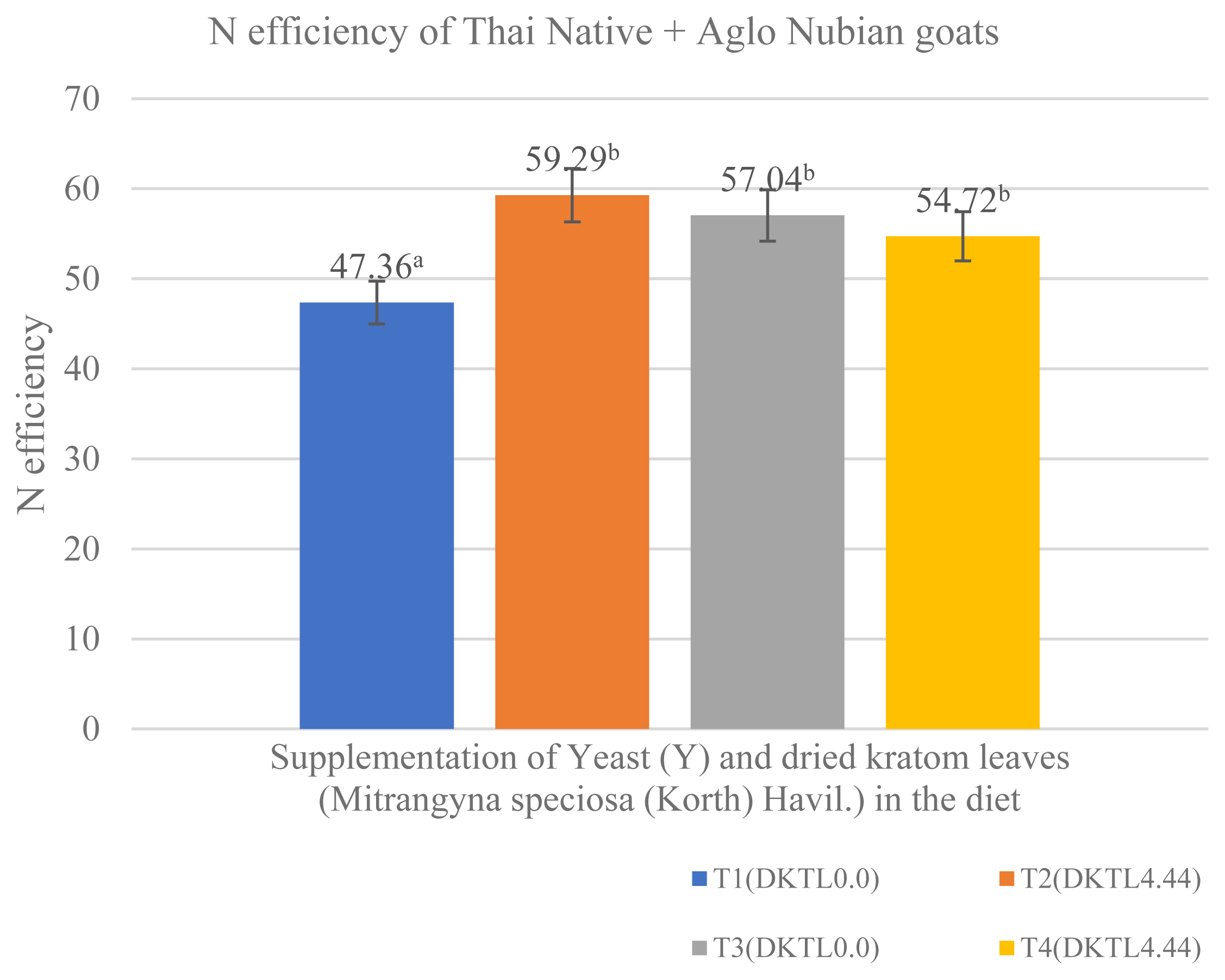3. Opsi F, Fortina R, Tassone S, Bodas R, López S. Effects of inactivated and live cells of Saccharomyces cerevisiae on in vitro ruminal fermentation of diets with different forage: concentrate ratio. J Agric Sci 2012; 150:271–83.
https://doi.org/10.1017/S0021859611000578

6. Sriranga KR, Singh AK, Harini KR, et al. Insights of herbal supplements during transition period in dairy animals: An updated review. Iran J Appl Anim Sci 2021; 11:419–29.
7. Chanjula P, Wungsintaweekul J, Chiarawipa R, et al. Effect of feed supplement containing dried kratom leaves on apparent digestibility, rumen fermentation, serum antioxidants, hematology, and nitrogen balance in goats. Fermentation 2022; 8:131
https://doi.org/10.3390/fermentation8030131

11. National Research Council (NRC). Nutrient requirements of sheep. Washington DC, USA: National Academies Press; 1985.
12. Association of Official Analytical Chemist (AOAC). Official methods of analysis of the association of official analytical chemists, II. 15th edArlington, VA, USA: AOAC; 1990.
15. Makkar HPS, Becker K. Vanillin-HCl method for condensed tannins: effect of organic solvents used for extraction of tannins. J Chem Ecol 1993; 19:613–21.
https://doi.org/10.1007/BF00984996


16. Association of Official Analytical Chemist (AOAC). The Official Methods of Analysis of the Association of Official Analytical Chemist. 16th edArlington, VA, USA: AOAC; 1998.
17. Chen XB, Hovell FD, Ørskov ER, Brown DS. Excretion of purine derivatives by ruminants: effect of exogenous nucleic acid supply on purine derivative excretion by sheep. Br J Nutr 1990; 63:131–42.
https://doi.org/10.1079/BJN19900098


18. Chen XB, Gomes MJ. Estimation of microbial protein supply to sheep and cattle based on urinary excretion of purine derivatives: an overview of the technical details. Bucksburn Aberdeen, UK: International Feed Resources Unit; 1992.
19. Samuel M, Sagathewan S, Thomas J, Mathen G. An HPLC method for estimation of volatile fatty acids in rumimd fluid. Indian J Anim Sci 1997; 67:805–7.
21. Edwards JE, Huws SA, Kim EJ, Kingston-Smith AH. Characterization of the dynamics of initial bacterial colonization of nonconserved forage in the bovine rumen. FEMS Microbiol Ecol 2007; 62:323–35.
https://doi.org/10.1111/j.1574-6941.2007.00392.x


22. Galyean M. Laboratory procedure in animal nutrition research. Las Cruces, NM, USA: Department of Animal and Life Science, New Mexico State University, USA; 1989. 188:p. 543
23. Steel RG, Torrie JH. Principles and procedures of statistics, a biometrical approach. New York, NY, USA: McGraw-Hill Kogakusha, Ltd; 1980.
24. Prevete E, Hupli A, Marrinan S, et al. Exploring the use of Kratom (Mitragyna speciosa) via the YouTube data tool: A novel netnographic analysis. Emerg Trends Drugs Addict Health 2021; 1:100007
https://doi.org/10.1016/j.etdah.2021.100007

31. Dias ALG, Freitas JA, Micai B, Azevedo RA, Greco LF, Santos JEP. Effects of supplementing yeast culture to diets differing in starch content on performance and feeding behavior of dairy cows. J Dairy Sci 2018; 101:186–200.
https://doi.org/10.3168/jds.2017-13240


32. García CC, Mendoza MG, González MS, Cobos PM, Ortega CM, Ramirez LR. Effect of a yeast culture (Saccharomyces cerevisiae) and monensin on ruminal fermentation and digestion in sheep. Anim Feed Sci Technol 2000; 83:165–70.
https://doi.org/10.1016/S0377-8401(99)00126-1

35. Cieslak A, Zmora P, Matkowski A, et al. Tannins from Sanguisorba officinalis affect in vitro rumen methane production and fermentation. J Anim Plant Sci 2016; 26:54–62.
37. Phesatcha K, Wanapat M. Tropical legume supplementation influences microbial protein synthesis and rumen ecology. J Anim Physiol Anim Nutr 2017; 101:552–62.
https://doi.org/10.1111/jpn.12458

38. Chanjula P, Wungsintaweekul J, Chiarawipa R, et al. Effect of feed supplement containing dried kratom leaves on apparent digestibility, rumen fermentation, serum antioxidants, hematology, and nitrogen balance in goats. Fermentation 2022; 8:131
https://doi.org/10.3390/fermentation8030131

39. Anantasook N, Wanapat M, Cherdthong A. Manipulation of ruminal fermentation and methane production by supplementation of rain tree pod meal containing tannins and saponins in growing dairy steers. Anim Physiol Anim Nutr 2014; 98:50–5.
https://doi.org/10.1111/jpn.12029

40. Patra AK, Yu Z. Effects of vanillin, quillaja saponin, and essential oils on in vitro fermentation and protein-degrading microorganisms of the rumen. Appl Microbiol Biotechnol 2014; 98:897–905.
https://doi.org/10.1007/s00253-013-4930-x


41. Vicknasingam B, Narayanan S, Beng GT, Mansor SM. The informal use of ketum (Mitragyna speciosa) for opioid withdrawal in the northern states of peninsular Malaysia and implications for drug substitution therapy. Int J Drug Policy 2010; 21:283–8.
https://doi.org/10.1016/j.drugpo.2009.12.003


42. Phesatcha K, Wanapat M. Tropical legume supplementation influences microbial protein synthesis and rumen ecology. J Anim Physiol Anim Nutr 2017; 101:552–62.
https://doi.org/10.1111/jpn.12458

43. Wanapat M, Gunun P, Anantasook N, Kang S. Changes of rumen pH, fermentation and microbial population as influenced by different ratios of roughage (rice straw) to concentrate in dairy steers. J Agric Sci 2014; 152:675–85.
https://doi.org/10.1017/S0021859613000658

45. Broderick GA, Grabber JH, Muck RE, Hymes-Fecht UC. Replacing alfalfa silage with tannin-containing birdsfoot trefoil silage in total mixed rations for lactating dairy cows. J Dairy Sci 2017; 100:3548–62.
https://doi.org/10.3168/jds.2016-12073


47. Soltan YA, Natel AS, Araujo RC, Morsy AS, Abdalla AL. Progressive adaptation of sheep to a microencapsulated blend of essential oils: Ruminal fermentation, methane emission, nutrient digestibility, and microbial protein synthesis. Anim Feed Sci Technol 2018; 237:8–18.
https://doi.org/10.1016/j.anifeedsci.2018.01.004

48. Viennasay B, Totakul P, Matra M, Phesatcha B, Wanapat M. Influence of bamboo grass (Tiliacora triandra, Diels) pellet supplementation on in vitro fermentation and methane mitigation. J Sci Food Agric 2022; 102:4927–32.
https://doi.org/10.1002/jsfa.11858


49. Yang K, Wei C, Zhao GY, Xu ZW, Lin SX. Effects of dietary supplementing tannic acid in the ration of beef cattle on rumen fermentation, methane emission, microbial flora and nutrient digestibility. J Anim Physiol Anim Nutr 2017; 101:302–10.
https://doi.org/10.1111/jpn.12531

51. Williams PE, Tait CA, Innes GM, Newbold CJ. Effects of the inclusion of yeast culture (Saccharomyces cerevisiae plus growth medium) in the diet of dairy cows on milk yield and forage degradation and fermentation patterns in the rumen of steers. J Anim Sci 1991; 69:3016–26.
https://doi.org/10.2527/1991.6973016x











 PDF Links
PDF Links PubReader
PubReader ePub Link
ePub Link Full text via DOI
Full text via DOI Download Citation
Download Citation Print
Print





